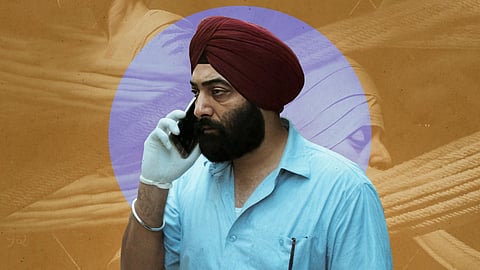
- Reviews
- Power List 2024
- Cannes 2024
- In-Depth Stories
- Web Stories
- News
- FC Lists
- Interviews
- Features
- FC SpecialsFC Specials

Director: Kanishk Verma
Writers: Soham Bhattacharyya, Fahim Irshad, Anagh Mukherjee
Cast: Manav Vij, Monica Panwar, Saloni Batra
Number of Episodes: 8
Streaming on: JioCinema
I’ve never watched a crime drama so long and grasped so little. Gaanth Chapter 1: Jamnaa Paar is the sort of series that’s so desperate to be ‘high-brow’ entertainment like Paatal Lok, Delhi Crime and Kohraa that it ties itself in knots. Ambition and a mouthful of a title aside, it doesn’t have the temperament or technique to construct a slow-burning investigative thriller. The director, Kanishk Verma (Sanak, Inside Edge 3), comes from a mainstream space. There are some telltale signs. For instance, the protagonist (Manav Vij) is a troubled Sikh policeman named ‘Gadar’ Singh, a Sunny Deol-sized ode to anger issues. I half-expected a hand-pump to be a plot point. The co-protagonist, Sakshi Murmu (Monica Panwar), is a psychiatric intern with Savant syndrome whose genius is depicted through that age-old floating-numbers visual. She is bullied by mean-girl-styled colleagues (“that psycho!”) at the hospital for being a lower-caste quota selection. Gadar’s backstory is sad-piano sad; he has an annoying daughter who starts every sentence with a cutesy “Papaaa” like a Nineties’ child artist. There’s a commissioner who is sinister because he eats samosas and spring rolls with a fork and knife. You get the gist.
This may sound like nitpicking, but it says a lot about the tonal disparity between what the eight-episode show thinks it is and what it actually is. In fact, even its ambition is a bit flawed. At first, Gaanth looks like yet another middling plunge into the Burari death case canon after Netflix’s House of Secrets and Hotstar’s Aakhri Sach. A suspended cop is summoned back to lead an investigation that starts with that infamous image of 11 hanging bodies in an East Delhi flat. The initial suspicion is a ritual mass suicide. The family diary and ambiguous flashbacks point to a shared psychosis, led by a son who was distressed after the patriarch’s demise. The pipes protruding from the walls are creepy. So far, so true. But then the series starts to exploit the real-life incident to cast a more conventional net over the mystery. It’s not an adaptation of the truth; it’s an opportunistic milking of it. At some level, it feels like historical revisionism for the sake of popular entertainment. I don’t think the intent is bad, but the gaze leaves a lot to be desired.
The writing goes in every direction possible – and hence goes nowhere. I will use question marks after the exceptionally surreal elements here. A surviving child who keeps getting trauma seizures. A shadowy black-hooded figure who behaves like they’re in a Mohit Suri movie? A PG room with a peeping tom. A domestic-help angle that critiques the Islamophobia of the police, media and society in general. A half-baked caste angle. A graveyard with an upside-down sadhu? A woman cop (Saloni Batra, in an anti-Soni role) who’s somehow active and passive at once. A senior doctor who speaks like a college girl and becomes Sakshi’s sidekick (in one of the many poorly worded exchanges, she calls her Savant syndrome a ‘sensory tsunami’)? A weird period twist that feels like a budget Da Vinci Code riff. A silver-tongued reporter who has tongue cancer? A severed head in a water tank. A nurse killing patients by injecting water bubbles into their blood? A systemic conspiracy against an incompetent cop (at one point, his daughter’s birthday party guests look at him in disgust and leave when they see a primetime telecast questioning his integrity – who the heck watches the news at a 7-year-old’s birthday?).
It’s hard to keep track because the big picture is replete with red herrings, cultural appropriations and narrative circles. And the small-picture energy is defined by individual scenes – rather than broader sequences they’re in – that play out like stagey soap opera moments. Towards the end, Rajesh Tailang (a staple in Delhi Crime) appears as a CBI agent and presents the most convincing version of the case. It’s the version we’re familiar with, and says more about the complicity of society and religion than any shadowy-killer cliche can. Yet, Gaanth insists on the random under-doggedness of Gadar and Sakshi in the face of cold logic. There is no conviction in the way it expands the lens. Some episodes end with a whimper disguised as a bang – like the discovery of a basement or an accident on a train.
The performances are only as effective as the chaotic writing. I like Manav Vij – he has that dead-eyed vibe that’s perfect for a haunted-cop template – but Gaanth gives him the blacks and whites without greys. Ditto for Monica Panwar, who plays a character’s condition more than the character itself. For a show almost entirely shot in Delhi, it also manages to look derivative. The creepy atmospheric look is no longer a novelty after the Netflix docuseries. The Sudeep Sharma hangover is writ large over a story that loses control of its own themes. Not to mention the fact that Gaanth is hesitant to replicate the original case because it's almost too twisted for its own good. The result is self-defeating. I can almost hear the makers go: Let’s reframe this as a long-drawn murder because everyone ‘thinks’ it’s a suicide. Never mind that the original account requires a proper psychological postmortem of an India most of us can barely fathom. I suppose the most chilling aspects of Gaanth, then, are the words that come after: Chapter 1. You know what that means. Is it even possible to be lost further in Chapter 2? This question mark is genuine.